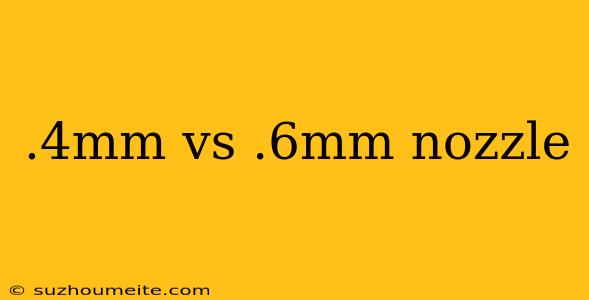.4mm vs .6mm Nozzle: Which One is Right for You?
When it comes to 3D printing, the nozzle is a crucial component that determines the quality and speed of your prints. Two of the most popular nozzle sizes are .4mm and .6mm, each with its own strengths and weaknesses. In this article, we'll dive into the differences between these two nozzle sizes and help you decide which one is right for your printing needs.
.4mm Nozzle
The .4mm nozzle is the most commonly used nozzle size in 3D printing. It's known for its high precision and ability to produce detailed prints with minimal layer heights. Here are some benefits of using a .4mm nozzle:
- Higher resolution: With a smaller nozzle diameter, you can achieve higher resolution prints with more detailed features and smoother surfaces.
- Faster print speeds: .4mm nozzles can print at faster speeds without sacrificing quality, making them ideal for production environments.
- Better for small prints: If you primarily print small objects, a .4mm nozzle is a great choice, as it can produce high-quality prints with minimal layer heights.
However, there are some drawbacks to using a .4mm nozzle:
- Clogged easier: The smaller diameter of the .4mm nozzle makes it more prone to clogging, especially when printing with thicker materials.
- More wear and tear: The smaller nozzle orifice can wear out faster, requiring more frequent replacements.
.6mm Nozzle
The .6mm nozzle is a larger alternative to the .4mm nozzle, offering some unique advantages:
- Less clogging: The larger diameter of the .6mm nozzle reduces the risk of clogging, making it ideal for printing with thicker materials or in dirty environments.
- Less wear and tear: The larger nozzle orifice is less prone to wear and tear, extending its lifespan and reducing maintenance costs.
- Better for thick materials: If you regularly print with thick materials like ABS or PETG, a .6mm nozzle is a good choice, as it can handle the higher extrusion rates required.
However, the .6mm nozzle also has some limitations:
- Lower resolution: The larger nozzle diameter can result in lower resolution prints with less detailed features and slightly rougher surfaces.
- Slower print speeds: .6mm nozzles typically print at slower speeds to maintain quality, making them less ideal for production environments.
Choosing the Right Nozzle Size
So, which nozzle size is right for you? Here are some factors to consider:
- Print resolution: If you need high-resolution prints with detailed features, a .4mm nozzle is the better choice. For lower-resolution prints, a .6mm nozzle may be sufficient.
- Material type: If you print with thick materials like ABS or PETG, a .6mm nozzle is a good option. For thinner materials like PLA or nylon, a .4mm nozzle is suitable.
- Print speed: If you prioritize print speed, a .4mm nozzle may be the better choice. For slower print speeds, a .6mm nozzle is acceptable.
Ultimately, the choice between a .4mm and .6mm nozzle comes down to your specific printing needs and preferences. Consider your printing goals, material types, and desired print quality to make an informed decision.
